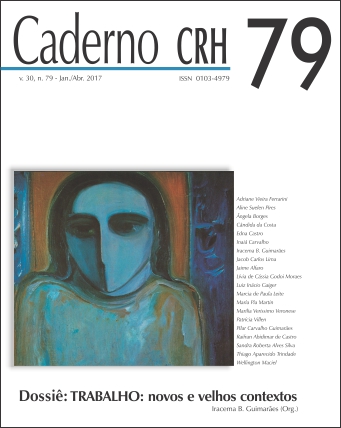NAS ASAS DO CAPITAL: EMBRAER, financeirização e implicações sobre os trabalhadores
DOI:
https://doi.org/10.9771/ccrh.v30i79.19925Keywords:
Palavras-Chave, Financeirização, Trabalho, EMBRAER, Reestruturação Produtiva, ExploraçãoAbstract
O objeto de análise deste artigo é o processo de crescente financeirização na empresa líder em aeronáutica no Brasil, a EMBRAER – Empresa Brasileira de Aeronáutica S.A, hoje, apenas EMBRAER S.A –, e os impactos sobre seus trabalhadores diretos e indiretos. A EMBRAER é a terceira maior produtora de aviões comerciais do mundo, cujo patamar de concorrência a faz primar por tendências organizacionais hegemônicas em âmbito mundial. A investigação, centrada em análise de conteúdo, a partir de documentos oficiais e pesquisas científicas até então publicadas, constatou quatro principais momentos de imbricação entre capital produtivo e capital fictício desde a sua privatização, em 1994, até o ano de 2012, quando se encerra a pesquisa: 1) a partir da década de 1990, quando a empresa foi privatizada; 2) de forma mais determinante, no início dos anos 2000, com a produção de aviões comerciais da família EMBRAER 170/190; 3) com a posterior pulverização de capitais, em 2006; e, por fim, 4) na mudança de razão social para fins de ampliação de áreas de atuação da empresa, em 2010. O contexto em que se dão tais mudanças é o de mundialização do capital e prevalência de acumulação fictícia de capital, com fortes impactos sobre intensificação do uso da força de trabalho.
The object of analysis in this article is the process of increasing financialization in the leading aeronautics company in Brazil, Brazilian Aeronautics Company S.A, (nowadays, only called EMBRAER S.A), and the impact on their direct and indirect workers. EMBRAER is the third biggest manufacturer of commercial airplanes in the world; thus, the level of competition makes the company privilege hegemonic organizational trends of global level. This investigation, centered on content analysis from official documents and scientific research published until then, verified four main moments of interconnections between productive capital and fictitious capital since its privatization in 1994, until 2012 when the research was finished. Thus, four moments come to light: 1) the 1990s, when the company was privatized; 2) in a determinant way, the beginning of the 2000’s with the manufacture of commercial airplanes EMBRAER 170/190; 3) the posterior pulverization of capital in 2006; and, finally, 4) the change of the corporate name for the purpose of expanding the areas of activity of the company in 2010. The context of such changes is that of the globalization of capital and the predominance of fictitious accumulation of capital with strong impacts in the intensification of workforce use.
Key words: Financialization; Work; EMBRAER; Restauration; Productive; Exploration
Le sujet de cet article est le processus de financiarisation croissante dans l’entreprise leuder de l’industrie d’aviation brésilienne, EMBRAER – Entreprise Brésilienne d’Aéronautique S.A, aujourd’hui, seulement EMBRAER S.A –, et ses concéquences sur le travail et ses travailleurs directs et indirects. L’EMBRAER est la troisième plus grande productrice d’avions commerciaux du monde, dont le niveau de la concurrence l’induit a donner la priorité à des tendances organisationnelles hégémoniques dans le contexte mondial. La recherche, concentrée sur l’analyse de contenu, à partir des documents officiels et des recherches scientifiques jusqu’à ce moment publiées, a identifié quatre principaux moments de forte chevauchement entre capital fictif et capital productif depuis sa privatisation, en 1994, jusqu’à l’année de 2012, quand quand la recherche se ferme: 1) à partir de 1994, quand l’entreprise a été privatisé ; 2) De façon déterminante, dans le début des années 2000, avec la production des avions commerciaux de la famille EMBRAER 170/190 ; 3) avec la subséquent pulvérisation des capitaux, en 2006; et, enfin, 4) aprés le changement de la dénomination sociale dont l’objectif était élargir les zones d’opération de l’entreprise, en 2010. Le contexte dans lequel ces changements se produisent est la mondialisation du capital avec la prévalence de l’accumulation de capital fictif , qui a des forts impacts sur l’utilisation intensifiée de la main-d’œuvre.
Key words: Financiarisation; Travail; EMBRAER; Restructuration Productive; Exploration
Downloads
Downloads
Published
How to Cite
Issue
Section
License
Todo o conteúdo da revista, exceto onde indicado de outra forma, é licenciado sob uma atribuição do tipo Creative Commons BY.
O periódico Caderno CRH on-line é aberto e gratuito.





